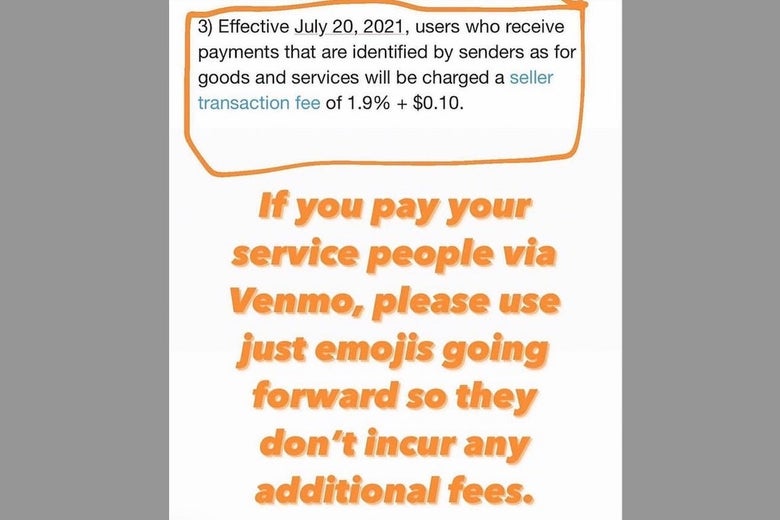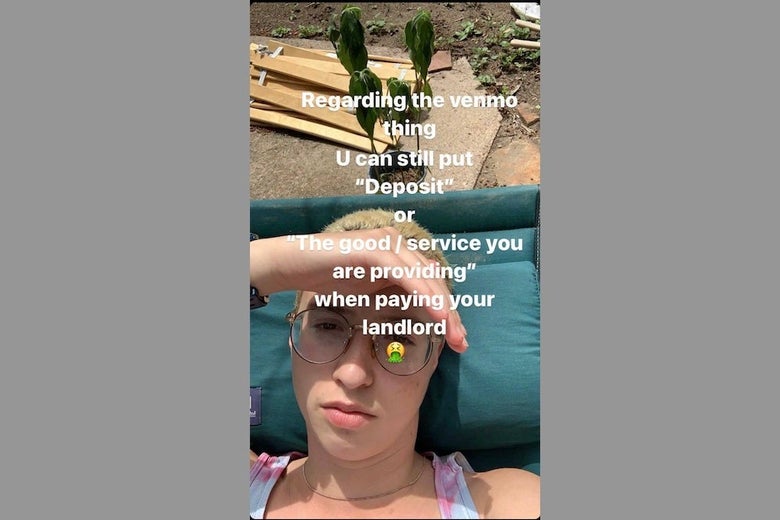A lot of businesses that rely on Venmo aren’t very pleased with the PayPal-owned money-transfer app right now, following an announcement last week about new and higher fees for certain functions. This includes a 1 percent to 1.5 percent hike for instant transfers of account funds to a bank, and a new 1.9 percent plus 10 cent transaction fee that users selling goods and services will have to pay. While this latter change won’t go into effect until July 20, users are already trying to figure out ways to skirt the forthcoming policy. On Twitter and Instagram, people are warning about this new fee and advising each other to use vague terms or just emojis in payment descriptions so that certain transactions won’t be flagged as being for “goods and services.” (In Venmo, you have to use the memo field every time you send or request money.)




Will this sort of subterfuge in the memo line actually help you avoid the “goods and services” fee? It certainly wouldn’t hurt, since Venmo has been cagey about the extent to which it monitors transactions, but tracking payment descriptions probably won’t be the primary mechanism by which the platform imposes this new fee. Instead, Venmo is encouraging buyers themselves to add a “good and services” tag to applicable transactions. In doing so, platform will automatically deduct the fee and cover the transaction with its Purchase Protection Program, in which Venmo will issue refunds in certain cases if the buyer disputes the sale by claiming that they did not receive the product or the product is significantly different from the seller’s description. Venmo claims this program protects buyers and sellers since neither party has to lose money to resolve the dispute. The fee and enrollment in the Purchase Protection Program is already the default for users who have a Venmo business account, so this change will only affect people are still conducting sales with their personal profiles—for example, a hair stylist or a craft-fair vendor. This change won’t be applicable for people who just use Venmo to, say, get reimbursed for picking up takeout for a friend.
As Vox reports, small business owners are worried that the new feature will on balance make it more expensive to use Venmo, and some are considering leaving the platform altogether. If you want to help a seller you’re buying from avoid Venmo’s new fees, it’s simple enough to not flag a transaction as being for goods and services. (On the flip side, buyers can now impose the fee on sellers out of spite.) The feature undoubtedly puts more pressure on sellers to convince buyers not to spring for the protection program. I asked Venmo whether it will be monitoring payment descriptions to see whether they fall under the “goods and services” category, and a spokesperson pointed me to a line in their announcement reading, “To send a goods or services payment, customers can simply toggle the button on the payment note screen to identify the payment as for a good or service.” I did not get a response when I followed up and asked, again, if that meant the platform would not be monitoring payment descriptions.
Venmo’s terms of service do dictate that individuals users cannot use personal accounts for commercial purposes unless explicitly authorized by the platform. Venmo has enforced this policy, albeit somewhat unevenly, in the past. Users have reported getting suspended for selling used items to friends long before Venmo’s announcement about the “goods and services” button, which suggests that platform does have some way of trying to detect commercial transactions. While it’s unclear if it actually relies on payment descriptions to do this, it makes sense that business owners who rely on the platform would want their customers to be as vague as possible in the subject line. Instead of writing “haircut,” why not try 🤽🍉🚂🐪?
"save" - Google News
July 02, 2021 at 04:55AM
https://ift.tt/3yjggRp
Will Emojis Really Save Venmo Sellers Money? - Slate
"save" - Google News
https://ift.tt/2SvBSrf
https://ift.tt/2zJxCxA
Bagikan Berita Ini














0 Response to "Will Emojis Really Save Venmo Sellers Money? - Slate"
Post a Comment